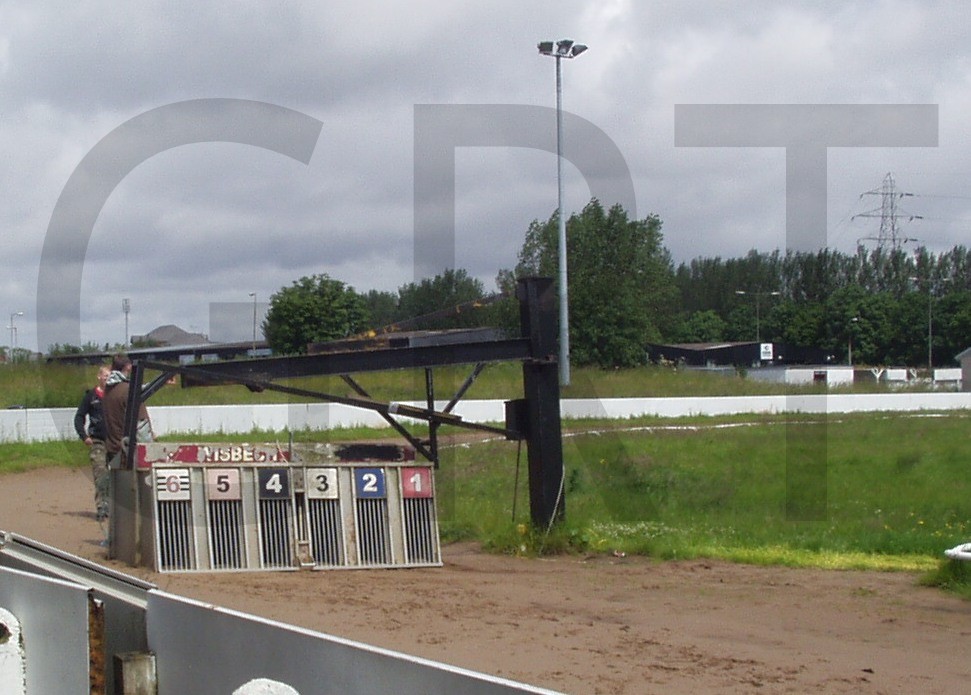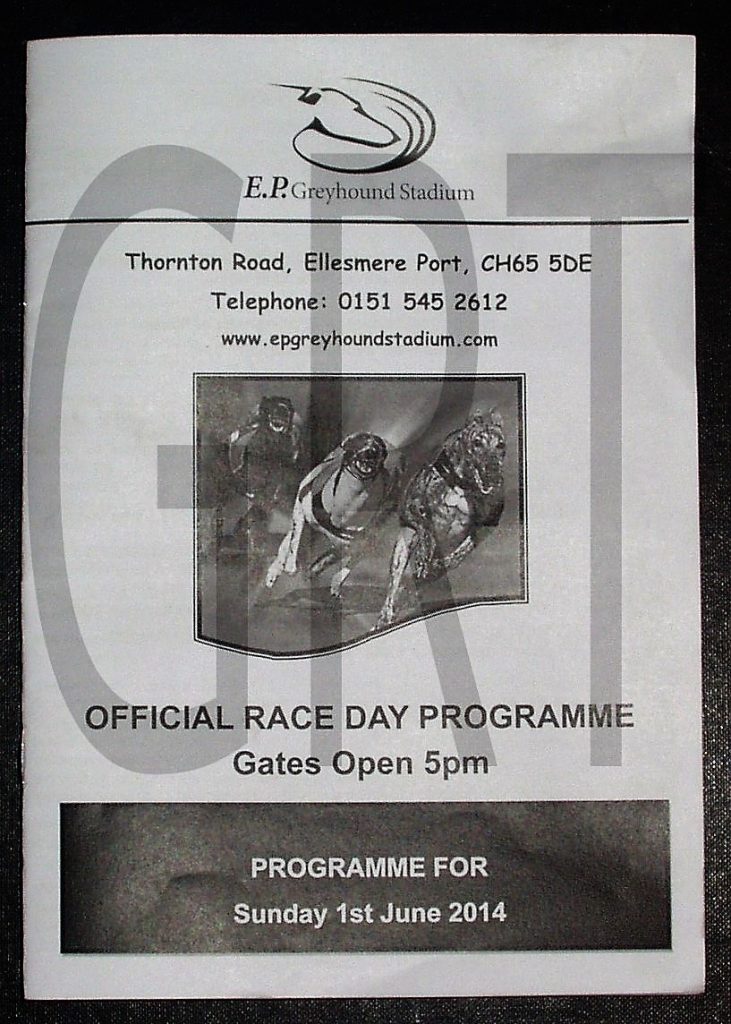Thornton Road, Ellesmere Port, The Wirral, Cheshire.
POSTCODE———————————CH65 5DE
LOCATED————————————Half a mile west of Ellesmere Port town centre along Thornton Road. The stadium was once clearly visible from the adjacent M53 motorway and signposted too from town centre.
ORIGINAL SITE—————————–Local football pitches.
DATE CONSTRUCTED——————-1968 as an amateur football ground.
DATE VENUE OPENED——————1968 for football opened by the then Manchester City football manager Joe Mercer who himself originated from Ellesmere Port.
Meaning other sports may have taken place prior to the arrival of Greyhound Racing.
FIRST MEETING—————————-February 29th 1988 a hound called Go Ben Go won the first race.
Greyhound Racing only.
LICENSED OR INDEPENDENT———Independent
All venues covered would have to be licensed with the government, licensed suggested in this section would refer to tracks operating under NGRC Rules.
INSIDE OR OUTSIDE HARE TYPE——Originally inside but switched to outside Swaffham during its latter years.
Please note that the Electric Hare suggested is only a guidance and would have been in operation for a certain amount of time at this venue. Although it is not necessarily guaranteed that it was operational all the time, as other types of lure may have been used and updated as time progressed.
DISTANCES———————————–265 and 465 metres.
Please note that most racing venues distances had become varied throughout the years, the ones given above were at once point set and offers only a guidance to the track size.
CIRCUMFERENCE—————————Not known.
Please note that alterations at most racing venues throughout its existence would see that the circumference of the track would vary, the one shown above offers only a guidance to the track size.
BIG RACE NAMES—————————Cheshire Oaks and The Whitbread Open.
STADIUM SHARED WITH——————Speedway from March 1972 until December 1985, Stock Car Racing and also Amateur football.
LAST MEETING——————————-Sunday June 1st 2014 a hound called Rumple won the very last race.
Greyhound Racing only.
STADIUM CLOSURE DATE—————–June 1st 2014.
Meaning other sports may have taken place after Greyhound Racing had ceased.
STADIUM DEMOLITION——————–2014-15.
BUILT ON SITE——————————–New Housing on Chase Park Estate.
In some cases, structure’s that originally covered the venue after the stadium had been demolished, may have been themselves demolished too, so the one described is more likely to be the one which now presently covers the site.
EVIDENCE LEFT TODAY——————–Nothing known of.
FURTHER COMMENTS———————My two greyhounds were the very last two to be graded at Ellesmere Port on the Sunday night prior to its announcement of its closure the following morning. Cost me a tenner plus fuel costs for nothing, that’s dog racing… nothing goes to plan.
















Nolan the last Derby winner at Ellesmere Port on 29th September 2013. Set a new track record that still stands of 27.37 in the final. Trained by Albert Currington on behalf of Ray Ogden and allegedly a well known Nottingham based trainer.


The Wirral is a section of land found in the North West of England, on a peninsula linked to the mainland that juts out towards the Irish Sea, and is bordered by the Dee Estuary and the River Mersey. But what is surprising is that the area became home to only one recognised greyhound stadium, that of Ellesmere Port. It was located about half a mile west of Ellesmere’s town centre, on the edge of a council housing estate overlooked by the busy M53 motorway.
The original site had been a cluster of council owned football pitches used by local amateur teams, but it wasn’t until the late 1960’s that a more recognised enclosed football ground began to take shape. The stadium was opened in 1968 by Joe Mercer, who was the then present manager of Manchester City, and had grown up in its surroundings as a child.
In 1971 more developments began to take place, after the council issued a lease to allow Speedway Racing to take place at the venue for the newly formed Ellesmere Port Gunners. The Gunners first meeting came on the 28th March 1972, and became popular with enthusiasts, seeing its success last for the next eleven seasons before a dispute with its riders over payments, forced the club to disband in 1982. The Gunners did eventually return but it was for just one season only, with its final appearance coming on Boxing Day 1985. Once the speedway had gone, the shale track became tarmacked, due to the introduction of another motor sport, that of Stock Car racing. But the Stock Cars failed to make an impact with the locals and within two years that sport too had gone.
It was during 1987 that the council was approached by a greyhound promoter to take control of the lease, which in turn witnessed the tarmac surface to be ripped up and replaced with an all-sanded greyhound track. Ellesmere Ports first meeting came on the 27th of February 1988, a good crowd witnessed a greyhound called “Go Ben Go” win the first ever race. Although other sports had come and gone during the 1980’s, amateur football still remained on a pitch laid out on the infield of the track, with Ellesmere Port Town Football Club hosting matches there up until their disbandment in1994. By then Ellesmere Port had become well established as a successful flapping track, but now and again rumours would linger regarding it switching to run under NGRC rules.
Its big races events had seen the Cheshire Oaks and the Whitbread Open run over four bends, but it normally staged six dog handicapped races over distances of 265 and 465 metres, with the greyhounds chasing an outside Sumner type hare. But the turn of the 21st century had witnessed a decline in greyhound racing and Ellesmere began to feel the pinch like many others, with evidence seen through falling attendances and the reduced numbers of greyhounds available, which had contributed to meetings being reduced to just one per week. More concerns had shown in January 2012 after the large stand on the back straight was demolished after being declared unsafe by the council.
Unknown at the time Ellesmere Ports final meeting came on the 30th June 2012, with a dog called “Greys Dilemma” winning the last race. The two dates arranged for the following meetings never materialised as there was not enough greyhounds to fill the card, with an announcement eventually taking place on the 12th of July that no further racing would take place. Things looked very gloomy for the Thornton Road track indeed, as the venue remained idle and even an attempt to bring back speedway racing was rejected by the council.
By the Autumn of 2012 rumours were emerging that certain parties were showing interest in bringing greyhound racing back to Ellesmere once more. As the trees began to shed their autumn leaves, it was apparent that the rumours were showing some truth as considerable repairs were being made to the stadium’s facilities. A new hare rail was being installed along with the construction a new kennel block, and tons of new sand was ordered to replace the weeds that now had overwhelmed the old track. The clubhouse was refurbished, with added ideas suggesting that racing could be run under NGRC Rules. After a heavy investment of a reported £170,000, and with new staff in place, Ellesmere Port was about to stage greyhound racing once more with a meeting arranged for the 24th of March 2013.
Ellesmere Port opened up once again as a flapping track, with the rumours of switching to NGRC rules not being totally ruled out, but this time with the added incentive of an impressive £86 prize money which would be paid to all race winners, proved to attract more entries. Yet even with the added incentive of better prize money, The Port failed to fulfil two meetings per week, and as time moved on, trainers and owners became disillusioned with how things were being run at the track. The cost of trials and prices in the canteen began to rise, along with the entrance fee, which had seen an increase of 60% to an unexplainable £8.50. The cost of racing a greyhound there had become too much for the regular dog man, along with added soaring fuel costs at the time, the sport was showing a weakness there once more.
It seemed as though The Port had all the ingredients to see the sport fail, as the number of patrons through the turnstiles began to fall drastically. It was on a Sunday evening of the 1st of June 2014 that Ellesmere Port staged its final meeting, unknown at the time, the 30 or so who had attended the meeting, along with a handful of trial dog owners, witnessed a dog called Rumple win the very last race. It wasn’t until the following morning, that news began to filter through that The Port had ceased trading. The news had come as a complete shock to many, as nothing had been mentioned the previous day, even grading trials were being staged after the meeting, I know that is fact because my brindle bitch was the last one to grade there.
Sadly, but not surprisingly, the stadium now lay in the hands of developers, who were slowly binding their time for the stadium to be bulldozed. It wasn’t long before their wish came true, and within two years the site disappeared beneath the foundations of new housing. Modern housing known on the Chase Park Estate which lies alongside Thornton Road, now covers the site.

Recent Comments